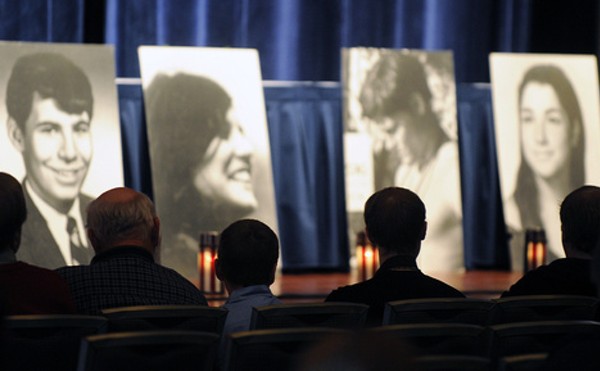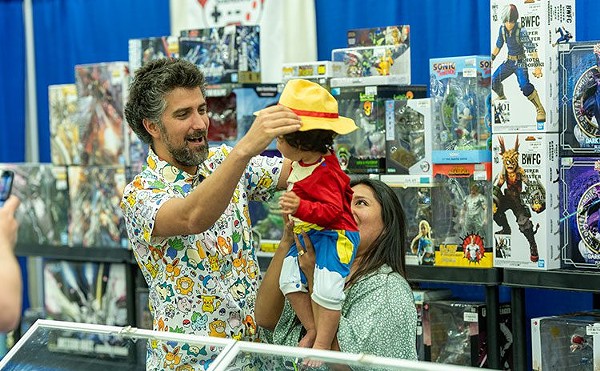How Chips Cronen, the cyclist who died on the Second Street Bridge earlier this month,
will help change the way you think about road riding — for the better

Like always, the experienced cyclist and active 57-year-old was wearing his helmet. He rarely, if ever, rode without an orange reflective vest, like you’d see on a construction site. He had just bought a mirror to help with awareness. He kept to the right side of the right southbound lane, the way Kentucky law says you’re supposed to.
Behind Chips was an older blue Ford Econoline, its driver bearing on the cyclist without realizing it. As we understand subconsciously, human beings confronted with such a grim guarantee, it only takes once. The police report said the van was going between 30 and 35 miles an hour. Chips hit the van and then a steel girder; he died on the bridge, bicycle a pretzel of scrap metal. With no warning or premonition, it ripped from those close to him the idyll of pleasant, sunny Tuesday afternoons, probably forever.
His wife of 39 years, Barbara, told me during a tearful phone conversation last week, “I know that if anything good can come of his death, Chips would be happy.”
That seems imminent. Ed Tonini — Chips’ brother-in-law and vice president for advocacy at the Louisville Bicycle Club — began talking with Metro government three months ago about increasing safety measures for cyclists on the Second Street Bridge. He was scheduled to meet with Mayor Abramson and staff July 6 about adding “Share the Road” signs and “sharrows” — street markings featuring a stenciled bicycle and two chevrons — to the Second Street Bridge, widely considered one of the greatest hazards to cyclists in Louisville.
He missed that meeting. He was at the funeral home.
In the interest of disclosure, I should say that I knew Chips Cronen and most of his immediate family. I went to school with, at various times, three of his five sons. Chips was my baseball coach way back when I liked baseball. We often admired his legit collection of baseball jerseys. When decorum required, he wore bow ties. Taller than average and thin with an undercurrent of muscle, he wore round, dark-rimmed glasses back then. They seemed to complement the bow tie with unusual grace.
I should also say it’s been since I liked baseball that I spoke to Chips and, with the exception of a few chance meetings with a couple of his sons, any of the Cronen family. To say I really “knew” him is presumptuous. I knew a sliver of his personality, a persona that required him to keep reign over a gaggle of exuberant kids lusting over the summer sports season.
 Cronen.img_assist_view.jpg)
Along with his love of baseball — and an obvious devotion to his athletically inclined children, most overtly through his coaching — Chips liked riding his bike.
“He just loved to ride,” Barbara said. “He was just there for the enjoyment of it.” She told me his ardor for cycling was simple and straightforward, without any agenda.
“I know Chips is in Heaven,” Barbara said, “and I know he had a right of way on the road.”
The driver of the van, a Jeffersonville, Ind. resident, told police he didn’t see Chips in front of him. The accident report says the driver “was not properly watching the roadway ahead.” There is a slight arc to the Second Street Bridge, and a point just beyond the crest where a cyclist could be obscured even from someone driving the speed limit. An active cyclist, I’ve been warned about that bridge and, particularly, that spot. When I gave up my car for a story this spring, my editor — a Hoosier who traverses the bridge daily — said it’s only a matter of time before something terrible happens there.
But it is more than a single collision or a rattling lapse of judgment. At about nine-and-a-half feet, the lanes on the bridge are barely wide enough for SUVs, vans and trucks, and particularly for the shared-road scenario cyclists and motorists must embrace every day to travel between states — the Second Street Bridge is the only way a cyclist can cross the Ohio River at any point reasonably near here. As early as 2002, Metro officials were lobbying the Federal Highway Administration to help fast track a solution to the dangerous bridge; the plan for the Ohio River Bridges Project, which seems like the most efficient way to remedy the situation, failed to include a more viable cross-river option for anyone but motorists.
Though a lot of dedicated people are trying to change it, Louisville is not a cyclist’s city. Our roads were made for cars. Nothing short of a culture change will make Louisville bike-friendly.
In the July-August Louisville Bicycle Club newsletter, Tonini recounted a recent trip to Denver, writing, “In Louisville, the concept of commuting downtown during rush hour is still a little imposing, but I discovered that Denver has made a solid commitment to cyclists, making the alternative mode of transportation safe and acceptable.” He had just begun lobbying the Mayor’s Office and local transportation officials for sharrows and other markings designed to make drivers more aware of their legal responsibility to share the road with cyclists. Their first project was the Second Street Bridge.
The bridge is a state roadway, which means the city can’t put up signs or paint sharrows without state approval. Chris Poynter, a spokesman for Mayor Abramson, said they expect that to come any day now, fairly remarkable turnaround time for this kind of bureaucratic action. The federal government still considers sharrows “experimental,” and because of that, is stricter in doling out funds to install them, which Metro applied for last December.
An April 9 letter to the Federal Highway Administration outlines an extensive plan to implement sharrows on several downtown roadways, as well as in West Louisville, Butchertown and Old Louisville. Jon Villines, Metro bicycle and pedestrian coordinator, said the city already has federal approval to use sharrows on Metro-maintained roads, and after a brief period of study, will begin installing them.
Used in conjunction with additional signs reminding motorists to share the road, Poynter said, sharrows will help fill gaps left in Louisville’s other noticeable bike-friendly initiative: dedicated bike lanes. As any serious cyclist here knows, there are points at which the lanes simply disappear.
In the immediate, there is also the matter of what happens to the driver of the van. As of now, no charges have been filed, and the investigation has been handed over to Commonwealth’s Attorney Dave Stengel’s office. Tonini said the Cronen family would not pursue charges against the driver.
Jackie Green, owner of the Bike Depot, led a small group of cyclists delivering requests last week to the offices of the Commonwealth Attorney, Metro Police Chief Robert White and Mayor Abramson, asking that they pursue felony charges against the driver. During the demonstration, Green pulled a faux coffin on a trailer behind his bike.
“This is not about that individual death,” he said later in a phone interview. “This is about those of us who want to ride the streets safely. This is a crime against the community.”
Kentucky law does not allow for criminal prosecution in cases like this, said Officer Phil Russell, Metro Police spokesman, because that requires proof of intent; here, the driver was simply not paying attention. Typically more vociferous an advocate than Tonini, Green’s request argues second-degree manslaughter and reckless homicide, both felonies, should apply to cases where a motorist kills a cyclist.
The process of re-educating the motoring public — and reminding cyclists that they are expected to mind the rules of the road just like any car — will likely be a long one, but Tonini remains hopeful. “In order for Chips’ death not to be a total loss, I would like to leverage
 Cronen.img_assist_view.jpg)
With every death comes meaning in some form, and with tragedy should come learning. Though the lesson the larger community will take from Chips comes at a devastating cost, it remains nonetheless: Share the Road.
Contact the writer at
[email protected]





